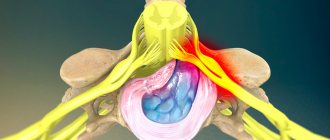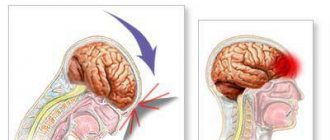The relationship between VSD and cervical osteochondrosis
Relationship between VSD and cervical osteochondrosis
Cervical osteochondrosis is destruction of the spinal column in the cervical region and deformation of the intervertebral discs. In the presence of this disease, the vertebral discs are deformed and destroyed. Nerve endings and blood vessels are compressed, causing poor circulation in the brain. As a result, vegetative-vascular dystonia develops.
Physical health gradually deteriorates, headaches, dizziness, surges in blood pressure, increased heart rate, causeless fear and panic attacks appear. There are enough provoking factors causing the appearance of the disorder. However, to treat VSD, you will need to find the underlying cause of the pathology.
Cervical osteochondrosis occurs due to deformation of the vertebral discs. The discs collapse and become mobile. As a result, any movement leads to irritation of nerve endings and blood vessels, which cause pain in the cervical spine. Correctly selected treatment will help prevent the development of intervertebral hernia. Otherwise, the blood supply to the brain will be disrupted, and pain will appear in the thoracic and cervical spine. Discomfort leads to headaches, rapid heartbeat with signs of tachycardia, and dizziness, which are similar to the symptoms of vegetative-vascular dystonia.
VSD and heart problems
The heart reacts to what is happening around before others. That is why, when something important and exciting is about to happen, we accompany it with the phrase “I feel it in my heart.” This vital organ is protected by a whole system of barricades, but sometimes the disease penetrates inside, as, for example, in the case of VSD.
What causes chest pain in people with VSD?
With such a diagnosis, the patient, without realizing it, draws attention to his heart. Everything that happens in the area of this organ is attributed to problems with it. How could it be otherwise if these reactions determine how you feel?! People who have been diagnosed with vegetative-vascular dystonia, every time there are interruptions in the work of the heart, are afraid that their life will end. It seems to many that the pain passes right through this organ, but in fact it is localized in the chest, on the left, or at the sternum. Some patients do not think about the fact that the problems may be far from “heart-related”. If it hurts on the left side of the chest, it’s the heart. It scares. Really, what else could hurt in this area? After all, our main organ is located here, and you feel the heart beating and the blood pulsating through the veins. The work of other “mechanisms” is hidden from us. For example, the process of secreting gastric juice.
Patients diagnosed with VSD are overly attentive to their own heart. They constantly calculate the pulse, measure blood pressure, and walk around with a blood pressure monitor. These people constantly come to do ECGs. They are not against carrying out newfangled procedures, just to calm their hearts, to find out where the dog is buried. But there is no benefit from this.
The cause of pain in the heart during VSD is not organic diseases of this organ, but a disruption of the autonomic nervous system, as a result of which the hormonal system begins to react incorrectly to what is happening in the body. It is likely that the numerous ECGs that were performed before reading this article convinced you that this is not a hidden myocardial infarction or similar diseases. All of them have cardiac symptoms, but here it’s different.
Pain during VSD, what is it like?
The pain that appears in the cardiac region can be different:
- Stabbing;
- Burning;
- Aching;
- Acute;
- Pressing;
- Compressive;
- cutting;
- Blunt;
- Constant;
- Periodic.
In addition to the fact that a person experiences pain, the heart rhythm is also disturbed. This could be arrhythmia, when the pulse is erratic, or tachycardia (the organ beats too quickly). In some cases, extrasystole occurs, that is, an extraordinary contraction of an organ, or cardiac arrest when it does not contract one or more times. Such changes cause fear of death in patients.
What is characteristic of pain in the heart area during VSD?
To understand that pain is caused by VSD and is not associated with any heart disease, it is important to know its distinctive features and characteristics. They consist in the fact that pain:
- Do not occur during physical exercise. A person feels discomfort after exercise.
- Appears with movement and stops at rest. If you observe that you have just such a case, then most likely it is myositis - a disease in which muscles become inflamed, or intercostal neuralgia.
- They do not disappear after taking drugs that dilate the heart vessels. Such medications include, for example, the well-known validol or nitroglycerin.
- They weaken as a result of the action of sedatives and tranquilizers. We are talking about phenazepam, Corvalol.
- They give rise to fear of death. It increases in proportion to the increase in pain.
the symptom of VSD in the form of heart pain is not confirmed by any examinations.
As a result of such activities, it is not possible to discover anything that would cause serious concern. Maximum - blockade of the Hiss bundle branches. Author: K.M.N., Academician of the Russian Academy of Medical Sciences M.A. Bobyr
Symptoms of VSD in cervical osteochondrosis
Symptoms of VSD in cervical osteochondrosis are characterized by the following features:
- Disturbance in the functioning of the heart and blood vessels (arrhythmia with the manifestation of tachycardia is observed).
- Hot flash or chills.
- Coldness in upper and lower extremities.
- Blood pressure surges.
- Paleness of the skin.
- Increased heart rate.
- Headache, dizziness, shortness of breath, difficulty breathing.
- Heaviness in the chest.
- Gastrointestinal disorders (attacks of nausea, heartburn, increased gas formation or diarrhea).
Increased sweating, panic attacks, fear, anxiety, irritability, and insomnia are observed. Regular fatigue, pain in the neck, and tinnitus appear.
One strike against two diseases! Cervical osteochondrosis and vegetative-vascular dystonia
“First they throw small stones at us to give something like a first warning. When we ignore pebbles, bricks fly at us. Don’t pay attention to the brick, and you will be crushed into powder by a huge boulder,” wrote psychologist E. Matthews.
This is how our body works, reporting problems: sometimes it stings, sometimes it aches or crunches... And if we do not react, timid “bells” can turn into alarm bells. Let's listen to the signals!
What is the “bell tolling” about?
Headache, dizziness, tachycardia, tinnitus, pressure surges... Perhaps these symptoms torment most people.
“I have vegetative-vascular dystonia...”, many people wave their hands and do nothing. Meanwhile, dystonia (VSD) is a malfunction in the functioning of the whole organism, which can lead to neuroses, depression, coronary heart disease, and arterial hypertension. And living with her is sometimes simply unbearable!
But this is not the only danger. This bouquet of signs is also characteristic of cervical osteochondrosis, in which, as a rule, progressive damage to the intervertebral discs, the appearance of hernias and osteophytes, and loss of function occur.
Cervical osteochondrosis can itself give a similar VSD picture, or it can cause the development of dystonia - in the case of vertebral artery syndrome, which is responsible for supplying the brain with oxygen, and radicular syndrome. Their compression can lead to headaches and other symptoms characteristic of VSD: irregular heartbeat, arrhythmia, pressure instability, shortness of breath, heaviness and pain in the heart, anxiety, panic attacks, insomnia, “floaters” before the eyes.
Both diagnoses can become a factor in the development of acute cerebrovascular accident – stroke. But if VSD is curable, then osteochondrosis is a progressive disease that requires control. The sooner measures are taken, the lower the risk of dangerous complications!
Features of the treatment of two problems
For osteochondrosis complicated by dystonia, chondroprotectors, anti-inflammatory and sedative drugs, muscle relaxants, antidepressants, beta-blockers, exercise therapy, massage, electrophoresis, magnetic field physiotherapy are prescribed - it makes it possible to stimulate cerebral circulation and saturate tissues with oxygen.
It is worth paying attention to the new product - the ALMAG+ medical device based on a magnetic pulse field. They can perform procedures both in clinical and in the comfort of home.
The convenience and capabilities of the new product have been increased. The device is specially adapted for convenient treatment of cervical osteochondrosis, as well as arthritis, arthrosis, osteochondrosis of other parts, osteoporosis, scoliosis, gout, vegetative-vascular dystonia.
ALMAG+ can help
:
- activate metabolism, improve blood circulation, accelerate the delivery of oxygen to the brain;
- stabilize blood pressure, prevent the development of hypertension;
- enhance the effect of painkillers and sedatives, reduce their quantity;
- relieve headaches, improve sleep;
- have a calming effect, reduce heart rate;
- relieve dizziness, visual and auditory disturbances.
- avoid complications, including stroke.
ALMAG+ for cervical osteochondrosis makes it possible
:
- eliminate shoulder and neck pain;
- relieve aggravation with a new regimen against inflammation and pain;
- get rid of stiffness and tightness of muscles.
ALMAG+ can be a profitable purchase aimed not only at preserving health, but also at saving money and time.
Convenient physical therapy to the next level. ALMAG+
Causes of pathology
A malfunction of the nervous system provokes the development of vegetative-vascular dystonia. Diagnosis of VSD is carried out in conjunction with an examination of the cervical spine. Different pathologies have similar signs and symptoms. To make a correct diagnosis, you will need to undergo a comprehensive examination. The main causes of cervical osteochondrosis that provoke the appearance of VSD include:
- Poor posture and curvature of the spine (scoliosis).
- Heredity.
- Serious injuries to the musculoskeletal system that caused circulatory problems.
- Stable physical activity associated with lifting heavy objects.
- Sedentary lifestyle.
As a result, muscle tissue becomes weak and intervertebral discs become mobile. This condition disrupts the functioning of the nervous system and causes the development of VSD.
Osteochondrosis, VSD. Should you worry so much about symptoms and diagnostic results?
Maxim, St. Petersburg
May 14, 2017
Good afternoon. I am 31 years old. Since childhood, I have been periodically (1-3 times a year, usually spring-autumn or winter or after an illness or stress) tormented by the following symptoms: foggy head, fatigue, quiet whistling in the ears, loss of appetite, depressed and very suspicious mood, reluctance something to do, slight dizziness, weakness in the arms and legs, I don’t sleep well. In my head at this moment I only think about illnesses, this only makes it worse and I work myself up to the point of fainting. Thoughts that this is some very serious disease or that doctors are missing something just itch in my head, I start reading a lot about diseases and symptoms and it gets even worse, fear of either dying or becoming a “vegetable” or going crazy. At peak moments, the pressure rises to 140-150 by 90-100, throws you into a fever and then into a cold sweat, and after 5 minutes everything rolls back and only the above symptoms remain. This condition can last from several days to several weeks. Sometimes the temperature reaches 37.3 during the day, in the morning and evening it is about 36.8-36.9. And indigestion, the stool becomes soft as if underdigested. Among chronic diseases - Gilbert's syndrome and VSD was diagnosed in childhood. Did various blood and urine tests. Clinical analysis is normal. Sugar and cholesterol are normal. Thyroid hormones and ultrasound are normal. Urine is normal. Now I have this condition again - it started 1.5 weeks ago with a sore throat (I have chronic tonsillitis), then I became hypothermic for several hours in the cold and wind, the sore throat quickly went away, but then everything that I described above began, plus the pressure was 120 /60-65 happens (is it worth panicking because of such a big difference?), measured in a lying position. And the temperature rises to 37.3 again. As a child, it seemed to me that it was somehow easier to bear, maybe I just had a simpler attitude towards it. Now I have done an X-ray of the cervical region, an EEG, and duplex scanning of blood vessels. X-ray shows initial signs of osteochondrosis c4-c6 and spondyloarthrosis c4-c7. EEG is a picture of mild changes in BEA of a combined nature, indirect signs of dyscirculatory disorders. The functional state of the regulatory structures of the trunk is unstable. Duplex scanning revealed no stenosis, pathological tortuosity, or atherosclerotic changes in the carotid arteries. In the subclavian - the main blood flow. PA without significant asymmetry in diameter and blood flow. The tortuous course of the VA in the bone canal. During rotation tests, the decrease in BFV in the right and left VA was more than 30%. Signs of distinct extravasal (vertebrogenic) influences on the blood flow of the left and more of the right VA. VBB blood flow in the subcompensation stage. Venous congestion of the 1st degree in the suboccipital venous plexus. A clinical blood test showed only: segmented - 45% when the norm is 47-72%. And LYMPH (lymphocytes) - 46% when the norm is 19-37%, is this for a sore throat and hypothermia? Is all this wealth related to osteochondrosis? And how will all this affect your future life? I would like to minimize these attacks or have less severe symptoms. Is it really possible to cope with this? Should I worry that much about this? It makes it very difficult to work, intellectual work, at the computer. In the intervals between exacerbations, my mood and other things are in complete order, nothing bothers me, I enjoy life. Thank you. Best regards, Maxim.
The question is closed
VSD
osteochondrosis
Diagnosis of VSD in cervical osteochondrosis
Signs of VSD and cervical osteochondrosis have similar symptoms to diseases of the brain and internal organs. In the absence of a complete diagnosis, self-medication is prohibited. To establish an accurate diagnosis, you will need to undergo a special examination of the body:
- ECG (electrocardiography)
- Ultrasound.
- Fluorography.
- X-ray.
- MRI of the cervical spine and brain.
- Ultrasound of blood vessels in the cervical spine.
- CT scan.
A comprehensive examination will help confirm or refute the presence of cervical osteochondrosis of the spine. In the absence of serious disorders with the manifestation of symptomatic disorders, vegetative-vascular dystonia is diagnosed.
Clinical picture
The combination of “VSD and cervical osteochondrosis” has specific symptoms:
- back pain;
- discomfort in the arms and legs along the nerve roots;
- numbness of fingers;
- development of intercostal neuralgia;
- crunching in the neck when turning the head;
- loss of sensitivity in hands and feet;
- "pins and needles" sensation in the limbs.
Cardiac symptoms
Cervicothoracic osteochondrosis and VSD are combined with cardiac symptoms. The heart begins to beat faster, and sometimes the pulse slows down. Painful sensations occur behind the sternum.
Some patients complain of vascular pulsation in the neck, arms, and legs. There is a fear of cardiac arrest.
Respiratory system
There is a feeling of lack of air with osteochondrosis. A person may complain that it is difficult for him to breathe, or that it is impossible to take a full breath. Sometimes there is shortness of breath. In advanced cases, it is present even when the person is lying or sitting.
The feeling of lack of air is combined with a feeling of heaviness in the chest. This symptom is aggravated when the patient lies down. Symptoms become more pronounced against the background of panic attacks.
Digestive system
With VSD and osteochondrosis, the following signs appear:
- bloating;
- nausea;
- heartburn;
- frequent urge to go to the toilet;
- diarrhea.
If a person is very worried, nausea occurs, and painful sensations appear in the stomach.
This symptomatology appears against the background of compression of the root of the thoracic spine.
Nervous system
The patient becomes too emotional, he can be irritated by any trifle. Meteorological dependence arises. A day that is too hot or cloudy can make you feel drowsy. Some patients have problems falling asleep.
A painful burning sensation occurs in the head with cervical osteochondrosis. Discomfort is explained by impaired venous outflow. Sometimes there is trembling and fainting.
Against the background of reduced blood flow, noise appears in the hearing organs. “Floaters” begin to flash before your eyes.
Other symptoms
With osteochondrosis, chills often occur. A person may also experience a sudden fever. Blood pressure “jumps” or decreases. There is a feeling of “flushing” in the arms, legs or face. Sweating increases.
Women have problems with menstruation, men have problems with potency.
Manifestation of PA
VSD, panic attacks and cervical osteochondrosis have the following common symptoms:
- increased heart rate;
- dyspnea;
- confusion of thoughts;
- sleep disturbance;
- dry mouth;
- pain syndrome in the heart area.
Panic attacks are also characterized by the appearance of unmotivated fears and obsessions. A person is usually afraid of going crazy or suddenly dying. Fear for loved ones is less common. Panic recedes as suddenly as it appeared.
Worsening of symptoms
When the pathology progresses, panic attacks with cervical osteochondrosis have more severe symptoms:
- disturbance of visual perception;
- dizziness;
- impairment of auditory perception;
- instability;
- numbness in the arms or legs;
- convulsive muscle contraction;
- tingling in the arms or legs.
Unsteadiness in gait may occur. Sometimes when new panic attacks occur, the feeling of fear becomes less.
Provoking factors
PAs can occur due to prolonged stay in a not very comfortable position. Emotional, physical or intellectual fatigue can play an unfavorable role.
Against this background, increased compression of the arteries occurs. The functioning of the brain is impaired.
Osteochondrosis accompanied by PA is aggravated by the presence of fear of new attacks.
Treatment of pathologies
It is impossible to eliminate the manifestations of vegetative-vascular dystonia without treatment for cervical osteochondrosis. All its symptoms will weaken or completely disappear at the stage of stable remission of the degenerative disease.
Drug treatment
In the treatment of cervical osteochondrosis directly, drugs of various clinical and pharmacological groups are used. These are non-steroidal anti-inflammatory drugs, muscle relaxants, glucocorticosteroids, B vitamins, ointments with a warming and local irritant effect.
Nonsteroidal anti-inflammatory drugs for spinal pathologies.
To eliminate functional disorders, patients are prescribed antidepressants, tranquilizers, and sedatives. A course of taking Glycine, Hopatenic and Glutamic acids, balanced complexes of vitamins and microelements can reduce the likelihood of panic attacks.
With pronounced manifestations of functional disorders, beta-blockers, psychostimulants, and antipsychotics are included in the therapeutic regimen.
Massage
In the treatment of cervical osteochondrosis, classic, acupressure, and cupping massage is used. Under mechanical influence, skeletal muscles relax, pinching of the vertebral artery and spinal roots is eliminated. Massage is an effective method not only for the treatment of osteochondrosis, but also for the prevention of its relapses.
Massage of the cervical-collar area.
Physiotherapy
Physiotherapeutic methods used in the treatment of cervical osteochondrosis also help get rid of the manifestations of VSD. Patients are prescribed magnetic therapy, laser therapy, UHF therapy, galvanic currents, and shock wave therapy. Neck pain caused by pinched spinal roots is treated well with applications of ozokerite and paraffin. And to normalize the psycho-emotional state and strengthen the body’s defenses, therapy with therapeutic mud and mineral waters is recommended for patients.
Acupuncture for osteochondrosis.
Neck exercises
Therapeutic gymnastics and physical exercise are the most effective way to get rid of all neurological symptoms of cervical osteochondrosis, including panic attacks. Most often, a physical therapy doctor includes the following exercises in the complex:
- stand up, spread your feet shoulder-width apart, rotate your head first in one direction, then in the other;
- in a sitting position, place your palm on your chin, try to tilt your head, while offering resistance with your hand;
- Sit up straight, place your palm on your cheek. Tilt your head to the side, resisting with your hand. Repeat the exercise in the opposite direction.
All movements must be performed without jerking, smoothly, slowly, with a small amplitude.
Psychological help
For individual psychological correction, patients are recommended to regularly visit a psychotherapist or psychologist, including group sessions. The doctor explains that you cannot allow yourself to give in to fear, anxiety, and worry. It is necessary to realize that the attack is provoked by another relapse of cervical osteochondrosis, and therefore is not a threat to life.
Traditional methods
Among the folk remedies in the treatment of cervical osteochondrosis and VSD, infusions of medicinal herbs with a mild sedative effect are used. To prepare them, pour a teaspoon of dry medicinal raw material with a glass of boiling water. After an hour, filter the infusion and take 100 ml up to 3 times a day. St. John's wort, motherwort, valerian, oregano, mint, lemon balm, and thyme have pronounced sedative activity.
Herbal collection.










